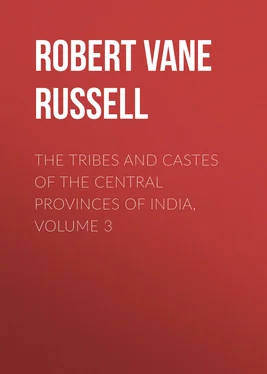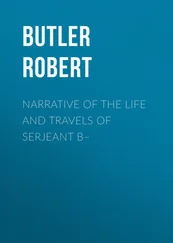Robert Vane Russell - The Tribes and Castes of the Central Provinces of India, Volume 3
Здесь есть возможность читать онлайн «Robert Vane Russell - The Tribes and Castes of the Central Provinces of India, Volume 3» — ознакомительный отрывок электронной книги совершенно бесплатно, а после прочтения отрывка купить полную версию. В некоторых случаях можно слушать аудио, скачать через торрент в формате fb2 и присутствует краткое содержание. Жанр: foreign_prose, История, foreign_edu, foreign_antique, на английском языке. Описание произведения, (предисловие) а так же отзывы посетителей доступны на портале библиотеки ЛибКат.
- Название:The Tribes and Castes of the Central Provinces of India, Volume 3
- Автор:
- Жанр:
- Год:неизвестен
- ISBN:нет данных
- Рейтинг книги:5 / 5. Голосов: 1
-
Избранное:Добавить в избранное
- Отзывы:
-
Ваша оценка:
- 100
- 1
- 2
- 3
- 4
- 5
The Tribes and Castes of the Central Provinces of India, Volume 3: краткое содержание, описание и аннотация
Предлагаем к чтению аннотацию, описание, краткое содержание или предисловие (зависит от того, что написал сам автор книги «The Tribes and Castes of the Central Provinces of India, Volume 3»). Если вы не нашли необходимую информацию о книге — напишите в комментариях, мы постараемся отыскать её.
The Tribes and Castes of the Central Provinces of India, Volume 3 — читать онлайн ознакомительный отрывок
Ниже представлен текст книги, разбитый по страницам. Система сохранения места последней прочитанной страницы, позволяет с удобством читать онлайн бесплатно книгу «The Tribes and Castes of the Central Provinces of India, Volume 3», без необходимости каждый раз заново искать на чём Вы остановились. Поставьте закладку, и сможете в любой момент перейти на страницу, на которой закончили чтение.
Интервал:
Закладка:
In another part of Bastar there were found to be five classes, and each class had a small number of septs in it. The people who supplied this information could not give the names of many septs. Thus Class A had six septs, Class B five, Classes C and D one each, Class E four, and Class F two. A man could not marry a woman of any sept belonging to his own class.
The Muria Gonds of Bastar have a few large exogamous septs or clans named in Hindi after animals, and each of these clans contains several subsepts with Gondi names. Thus the Bakaravans or Goat race contains the Garde, Kunjami, Karrami and Vadde septs. The Kachhimvans or Tortoise race has the Netāmi, Kawachi, Usendi and Tekāmi septs; the Nāgvans or Cobra race includes the Marāvi, Potāri, Karanga, Nurethi, Dhurwa and others. Other exogamous races are the Sodi (or tiger), Behainsa (buffalo), Netām (dog in Gondi), Chamchidai (bat) and one or two more. In this case the exogamous clans with Hindi names would appear to be a late division, and have perhaps been adopted because the meaning of the old Gondi names had been forgotten, or the septs were too numerous to be remembered.
In Chānda a classification according to the number of gods worshipped is found. There are four main groups worshipping seven, six, five and four gods respectively, and each group contains ten to fifteen septs. A man cannot marry a woman of any sept which worships the same number of gods as himself. Each group has a sacred animal which the members revere, that of the seven-god worshippers being a porcupine, of the six-god worshippers a tiger, of the five-god worshippers the sāras crane, and of the four-god worshippers a tortoise. As a rule the members of the different groups do not know the names of their gods, and in practice it is doubtful whether they restrict themselves to the proper number of gods of their own group. Formerly there were three-, two- and one-god worshippers, but in each of these classes it is said that there were only one or two septs, and they found that they were much inconvenienced by the paucity of their numbers, perhaps for purposes of communal worship and feasting, and hence they got themselves enrolled in the larger groups. In reality it would appear that the classification according to the number of gods worshipped is being forgotten, and the three lowest groups have disappeared. This conjecture is borne out by the fact that in Chhindwāra and other localities only two large classes remain who worship six and seven gods respectively, and marry with each other, the union of a man with a woman worshipping the same number of gods as himself being prohibited. Here, again, the small septs included in the groups appear to serve no purpose for regulating marriages. In Mandla the division according to the number of gods worshipped exists as in Chānda; but many Gonds have forgotten all particulars as to the gods, and say only that those septs which worship the same number of gods are bhaiband , or related to each other, and therefore cannot intermarry. In Betūl the division by numbers of gods appears to be wholly in abeyance. Here certain large septs, especially the Uika and Dhurwa, are subdivided into a number of subsepts, within each of which marriage is prohibited.
13. Totemism
Many of the septs are named after animals and plants. Among the commonest septs in all Districts are Markām, the mango tree; Tekām, the teak tree; Netām, the dog; Irpāchi, the mahua tree; Tumrāchi, the tendu tree; Warkara, the wild cat, and so on. Generally the members of a sept do not kill or injure their totem animals, but the rule is not always observed, and in some cases they now have some other object of veneration, possibly because they have forgotten the meaning of the sept name, or the object after which it is named has ceased to be sacred. Thus the Markām sept, though named after the mango, now venerate the tortoise, and this is also the case with the Netām sept in Bastar, though named after the dog. In Bastar a man revering the tortoise, though he will not catch the animal himself, will get one of his friends to catch it, and one revering the goat, if he wishes to kill a goat for a feast, will kill it not at his own house but at a friend’s. The meaning of the important sept names Marābi, Dhurwa and Uika has not been ascertained, and the members of the sept do not know it. In Mandla the Marābi sept are divided into the Eti Marābi and Padi Marābi, named after the goat and pig. The Eti or goat Marābi will not touch a goat nor sacrifice one to Bura Deo. They say that once their ancestors stole a goat and were caught by the owner, when they put a basket over it and prayed Bura Deo to change it into a pig, which he did. Therefore they sacrifice only pigs to Bura Deo, but apparently the Padi Marābi also both sacrifice and eat pigs. The Dhurwa sept are divided into the Tumrāchi and Nābalia Dhurwa, named after the tendu tree and the dwarf date-palm. The Nābalia Dhurwas will not cut a dwarf date-palm nor eat its fruit. They worship Bura Deo in this tree instead of in the sāj tree, making an iron doll to represent him and covering it with palm-leaves. The Uika sept in Mandla say that they revere no animal or plant, and can eat any animal or cut down any plant except the sāj tree, 57 57 Boswellia serrata.
the tree of Bura Deo; but in Betūl they are divided into several subsepts, each of which has a totem. The Parteti sept revere the crocodile. When a marriage is finished they make a sacrifice to the crocodile, and if they see one lying dead they break their earthen pots in token of mourning. The Warkara sept revere the wild cat; they also will not touch a village cat nor keep one in their house, and if a cat comes in they drive it out at once. The Kunjām sept revere the rat and do not kill it.
14. Connection of totemism with the gods
In Betūl the Gonds explain the totemistic names of their septs by saying that some incident connected with the animal, tree or other object occurred to the ancestor or priest of the sept while they were worshipping at the Deo-khulla or god’s place or threshing-floor. Mr. Ganga Prasād Khatri has made an interesting collection of these. The reason why these stories have been devised may be that the totem animals or plants have ceased to be revered on their own merits as ancestors or kinsmen of the sept, and it was therefore felt necessary to explain the sept name or sanctity attaching to the totem by associating it with the gods. If this were correct the process would be analogous to that by which an animal or plant is first held sacred of itself, and, when this feeling begins to decay with some recognition of its true nature, it is associated with an anthropomorphic god in order to preserve its sanctity. The following are some examples recorded by Mr. Ganga Prasād Khatri. Some of the examples are not associated with the gods.
Gajjāmi , subsept of Dhurwa sept. From gaj , an arrow. Their first ancestor killed a tiger with an arrow.
Gouribans Dhurwa. Their first ancestor worshipped his gods in a bamboo clump.
Kusadya Dhurwa. ( Kosa , tasar silk cocoon.) The first ancestor found a silk cocoon on the tree in which he worshipped his gods.
Kohkapath. Kohka is the fruit of the bhilawa 58 58 Semecarpus anacardium.
or marking-nut tree, and path , a kid. The first ancestor worshipped his gods in a bhilawa tree and offered a kid to them. Members of this sept do not eat the fruit or flowers of the bhilawa tree.
Jaglya. One who keeps awake, or the awakener. The first ancestor stayed awake the whole night in the Deo-khulla, or god’s threshing-floor.
Sariyām. ( Sarri , a path.) The first ancestor swept the path to the Deo-khulla.
Читать дальшеИнтервал:
Закладка:
Похожие книги на «The Tribes and Castes of the Central Provinces of India, Volume 3»
Представляем Вашему вниманию похожие книги на «The Tribes and Castes of the Central Provinces of India, Volume 3» списком для выбора. Мы отобрали схожую по названию и смыслу литературу в надежде предоставить читателям больше вариантов отыскать новые, интересные, ещё непрочитанные произведения.
Обсуждение, отзывы о книге «The Tribes and Castes of the Central Provinces of India, Volume 3» и просто собственные мнения читателей. Оставьте ваши комментарии, напишите, что Вы думаете о произведении, его смысле или главных героях. Укажите что конкретно понравилось, а что нет, и почему Вы так считаете.












